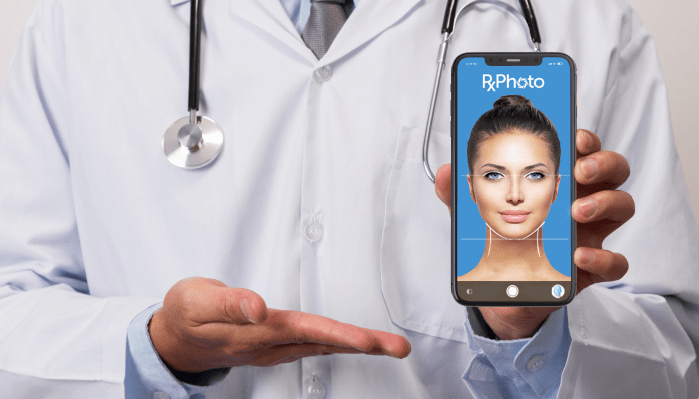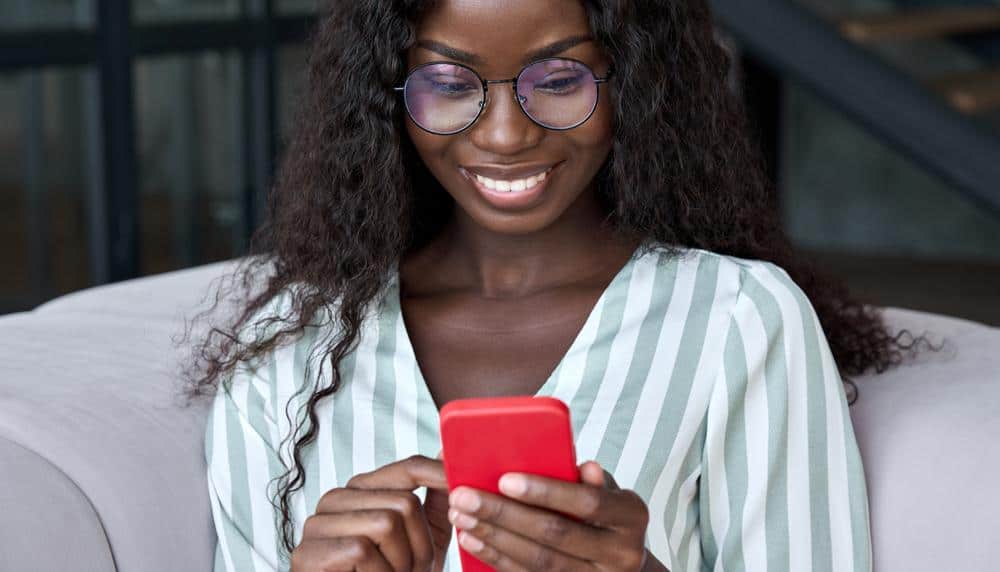The future of aesthetic patient photography is here. iPhones or iPads now boast photographic features that render their quality comparable to that of DSLR cameras. The recent release of the iPhone 14, iPhone 14 Pro and iPhone 14 Pro Max have gone where few iPhone cameras have gone before, boasting incredibly high resolution images capable of capturing astounding clarity, even in low light conditions. As one photographer put it, “the iPhone 14 Pro is the first phone that could replace my camera.”
The great news is that RxPhoto has also evolved alongside iOS advances. We’ve capitalized on this improved photographic technology, utilizing it to its maximum and further enhancing it with our specialized software.
The RxPhoto app enables those working in the medical and aesthetic fields to fully exploit the capability of the newest generation of iPhone cameras so you enjoy unparalleled quality in your patient before and after galleries. And as every savvy clinician knows, striking before and after galleries convert prospects, allow your team members to cross-sell more effectively, and showcase your clinic’s offerings.
Harnessing the power of iPhone advances for improved patient photography
Dual lens cameras first appeared in iOS devices in 2016. While existing iPhones and iPads were already equipped with a standard wide angle 12 megapixel lens, the inclusion of a telephoto lens signaled an advance for those in the aesthetics industry who use their iPhones to photograph patients. For those unfamiliar with photographic terminology, a telephoto lens is a long-focus lens with extended reach, allowing you to photograph a subject that is far away by magnifying the subject in the frame.
For starters, two lenses enable close-ups and zoom without compromising image quality. These two lenses enable you to capture patient close-ups more effectively. Second, the addition of a second lens improved portrait photography (the likes of which is commonly used in aesthetics) to the next level.
In 2019, the iPhone 11 Pro and Pro Max added a third and fourth lens to the mix: Three on the rear of the phone and one on the front. What did these additions mean for those working with patient photography? The addition of the ultra-wide lens on the back became a game-changer as it exaggerated the size of foreground objects relative to their background, highlighting the subject. RxPhoto has used the ultra-wide lens to add an additional 0.5x zoom mood, helping users to further utilize the ultra-wide angle view. The iPhone 11 Pro also added a form of integrated optical zoom, allowing you to get closer to your subject while maintaining optical quality. For photographing patients in medical or aesthetic contexts, high-quality optical zoom matters, because the devil is in the details.
Most recently, the release of the iPhone 14 Pro came with another upgrade of the main lens to 48MP using its ProRaw format. By enabling the ProRaw toggle, image resolution, clarity and detail is significantly improved from 12 to 48 MP. For aesthetic photographers looking to capture precision detail, 48MP can provide even beyond the capability of regular DSLR cameras, which often have 12MP lenses. A 48MP image also enables cropping of the image without losing detail–again, ideal for aesthetic practitioners who may wish to crop images for patient privacy to share in before and after galleries.
The iPhone 14 Pro also boasts improved detail in low light conditions thanks to a 65% increase in its main camera image sensor. By increasing the size of the image sensor, its low light performance is doubled. If you’re capturing patient images in a clinic with less than ideal light conditions, this represents a welcome advance.
Overall, these ongoing photographic upgrades have seen the difference between DSLR cameras and new generation iPhones narrow even further to the point that expert photographers are wowed by iPhone photographic capabilities. Take a look at this video comparing images shot by the iPhone 14 Pro and a professional camera, for example.
However, it’s still critical to remember that more lenses, larger image sensors and upgraded resolution doesn’t automatically mean more consistent photos. You also need a purpose-built medical photography program to fully harness the benefits of Apple’s capability to produce outstanding before and after patient photographs.
The benefits of teaming advanced iOS photographic capability with RxPhoto software
As iPhones have evolved, so too has RxPhoto. RxPhoto develops in accordance with Apple iOS code. This means that we integrate the full extent of Apple photographic capabilities into our software and enhance these capabilities specifically for medical photography.
Our iOS experts know exactly how to capture the benefits of each advance in Apple technology and translate them into exceptional patient photos. We’ve determined how to best exploit Apple technology for easy-to-use, striking, medical patient photography.
According to Tony, RxPhoto’s lead iOS developer, RxPhoto offers a marked edge over competitors.
“RxPhoto provides you with the best clinical photography experience in all aspects. It’s high quality, easy to use, ordered, and secure.”
Here are Tony’s pick of RxPhoto’s top seven features.
- The best photo possible, every time
Apple has a framework that assists with taking the best possible photo, regardless of the number of lenses of the iPhone being used.
“We use the Apple Camera Framework to optimize the use of all available lenses, so you get the best picture possible,” says Tony. This means no matter which model of iPhone you’re using, the pictures you take will always make the most of the lenses available..
- An extraordinary level of detail
Apple iPhones with two or three lenses also boast a unique framework which allows for precise photograph segmentation by separating the foreground from the background with high resolution. This mechanism separates the individual in the foreground from whatever is in the background with both detail and clarity.
RxPhoto utilizes this framework to standardize facial photo backgrounds. According to Tony, it’s an invaluable tool for medical and aesthetic photography.
“This feature can divide a person from their background precisely, and replace the background with some still image, such as a fully blue background.”
With this tool, the depth effect is rendered easier to preserve in high resolution, achieving a fine-grain level of detail. If you need to capture changes in hair, eyelashes, or fine facial lines in patient photographs, this level of detail is paramount.
- Apple’s machine-learning tool
Apple additionally offers a machine-learning tool that takes an image from a camera or photo and processes it. RxPhoto utilizes this for several tools that we will release in the future, including:
1. Background removal for devices that don’t have 2 or 3 lenses. We utilize this machine-learning tool to segment photos and remove the background.
2. Standardizing before and after photos. Using this tool, we can detect specific facial areas, for example, and guide RxPhoto users to perfect their photos.
- RxPhoto on-screen photo guides to improve photo accuracy and quality
The patented RxPhoto on-screen guiding system supports our users to take professional photos of their clients. Consistency is key when capturing clients undergoing treatments where improvements may incur gradually over multiple sessions. Displaying two photos side-by-side is a much more effective way of showing a 50 percent improvement than telling the patient they have a 50 percent improvement.
“RxPhoto software offers illustrated guides to help the user align with various parts of the anatomy,” says Tony. The software makes use of Apple’s accelerometer to remind you if you’re holding the camera straight. Even the least trained staff member can capture great shots with the RxPhoto guiding system.
Most impressively, RxPhoto also provides users with a patented “ghosting” feature which dramatically improves photo consistency. It allows the photographer to overlay a previous image onto the viewing screen, so that the new image is lined up perfectly, producing a photo that clearly displays a patient’s progress. The previous photo functions as a guide when taking a new photo. Highly standardized images render it much easier for patients to quickly compare before and after images.
- RxPhoto offers manual camera adjustments for users who want to get even more from their photos
RxPhoto has adjustable camera settings that allow the user to capture the perfect image. We utilize the Apple framework to adjust exposure and white balance parameters inside the viewfinder, so that users can create perfect settings for their room/area by adjusting the white balance and the exposure. While the iOS camera app can adjust exposure, it cannot adjust white balance. White balance is used to tweak colors to match the color of the light source so that white objects appear white rather than yellow or washed out. With RxPhoto, you can adjust both.
The ability to manually manipulate these settings is critical because it enables uniform lighting between before and after photos. For example, if lighting is inconsistent in a before image compared to an after image, the provider can use RxPhoto’s patented photo ghosting to match the lighting of the previous image to the lighting of the new image with the white balance & exposure toggles.
- RxPhoto allows you to strategically order and categorize your photographs
One of RxPhoto’s most useful organizational features enables the user to order photos based on your specifications, be it body area, procedure, age group, ethnicity or gender. When you can custom-organize your before and after galleries, the applications are numerous.
For example, photo galleries based on certain patient demographics can be pulled up in mere seconds, converting prospects in the consultation room by illustrating outcomes, showing them images of people similar to themselves (thus evoking an emotional response) and demonstrating the kinds of results they can expect.
- RxPhoto ensures patient photos are fully secure and compliant
Security and privacy is a fundamental consideration for those working within the aesthetic and medical industries. The HIPAA Privacy Rule establishes national standards to protect certain health information. The Security Rule establishes a national set of security standards for protecting specific health information that is held or transferred in electronic form, such as photographs. RxPhoto offers a HIPAA-compliant cloud service to protect patient photos and privacy. Both the practitioners at your clinic and your patients can rest easy knowing photographs are securely stored.
Not yet using RxPhoto? Here’s why you need it
If you aren’t yet using RxPhoto, you’re not fully exploiting the photographic capacity of your iPhone for the benefit of your clinic. Great photos convert consultations into clients. A stunning before and after series can convince a patient to sign up for a treatment that’s potentially worth thousands of dollars, or even lifetime value if you keep them satisfied and coming back. Exceptional photos also showcase your clinic’s talent and the procedures in which your staff really shine and stand out from the competition.
The importance of before and after galleries cannot be overstated. Research into the importance of galleries has long underscored that they are the single most searched item by prospective patients during the exploratory phase. According an RxPhoto survey, consumers who were researching a plastic surgery clinic ranked the following pages in terms of importance: Before and after gallery (42.9%); reviews and testimonials (37.7%); procedural information (28.6%); information about the practice (12.2%) and blog (1.6%). In other words, prospective patients place significantly more precedence on before and after galleries than staff credentials!
RxPhoto can help you create outstanding before and after galleries. RxPhoto’s fully-loaded suite of clinical photography tools also allows providers to produce better images, streamline activities, improve on patient care, increase patient education, and save on administrative costs. But medical photography software isn’t all we do–With RxPhoto, you can go completely paperless by using our digital intake form and charting templates. We’re reinventing medical photography, photo management, and provider and patient services as you know it. Watch this space.
You Might Also Like
Owner of Cavina Med Spa and mom of three, Blair Linsley, appears on this week's episode to share her journey from pediatric nursing to entrepreneurship. Blair delves into the driving…
Managing a medical practice can be challenging. Sometimes, the administrative burdens can often interfere with your ability to provide the level of patient care you’d like. But you can increase…
To attract repeat clients, must to remind them about the great service they've received. Too many clients are one-and-done — even if you have all their records in your EMR,…





